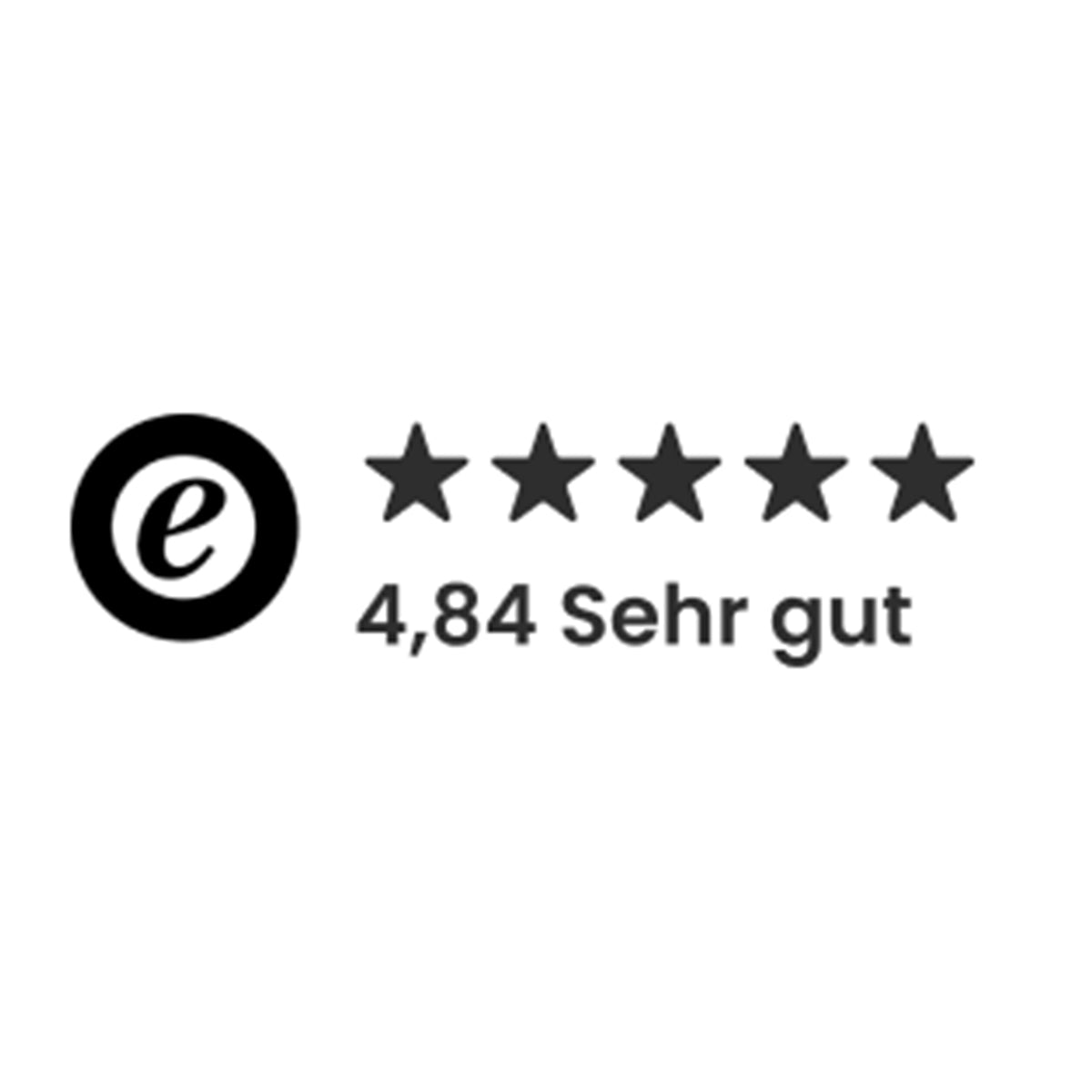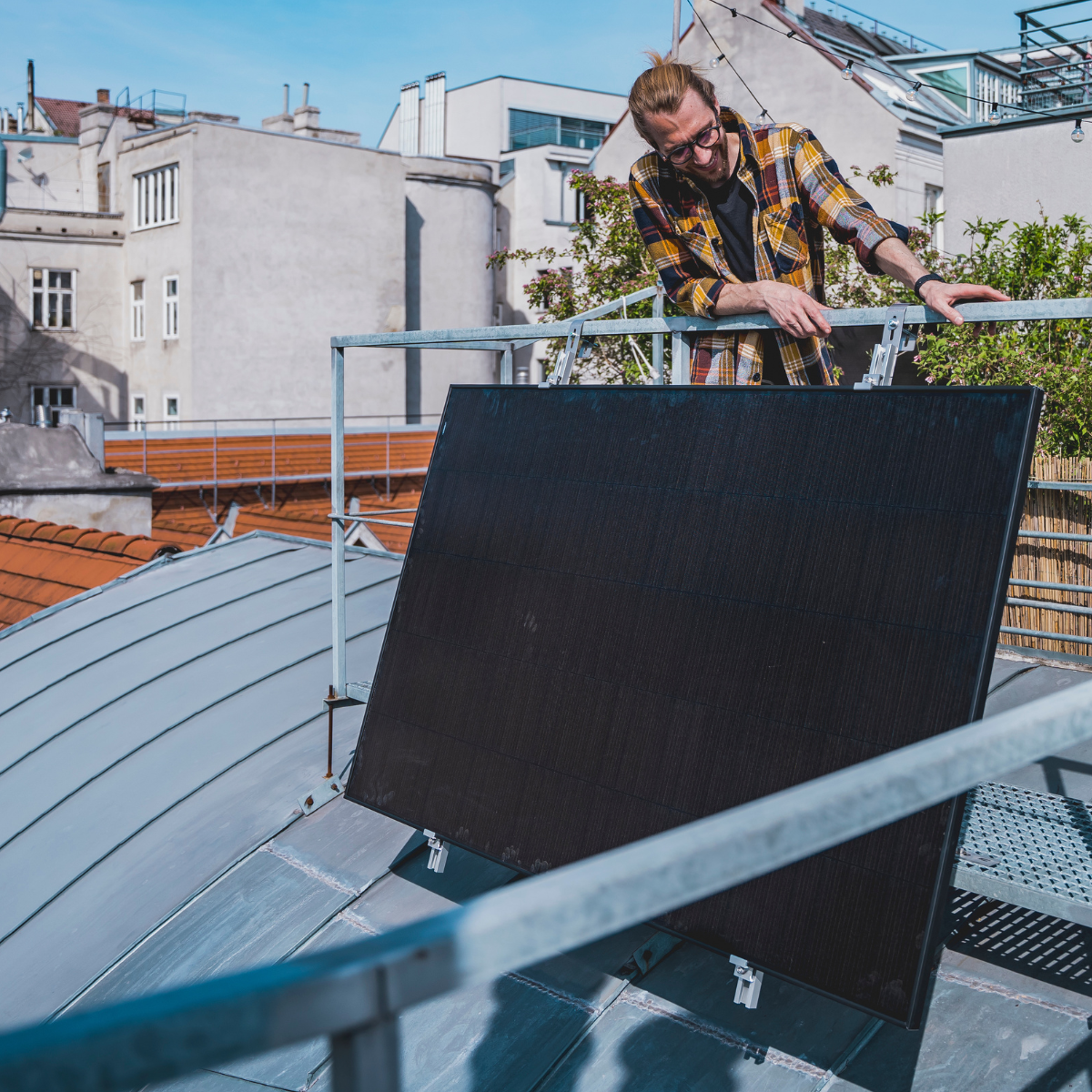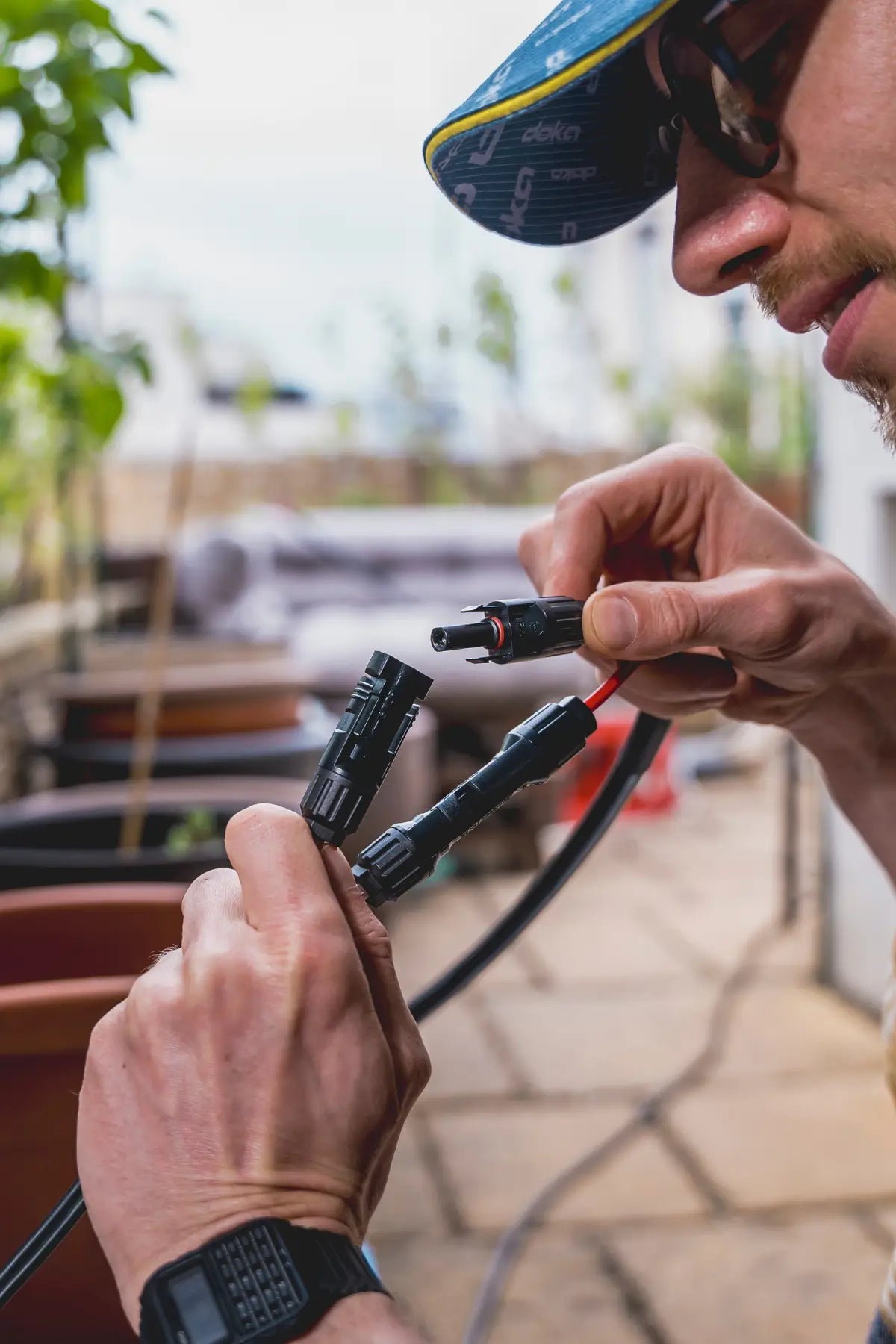You want to install solar modules on your motorhome, camper or balcony Are you installing solar panels and looking for the most efficient way to connect them? Then you've come to the right place. The way you connect your solar panels—whether in series, parallel, or mixed—has a decisive influence on the performance, efficiency, and safety of your photovoltaic system.
Especially with Balcony power plants and mobile solar systems on vans or motorhomes, the question often arises: Which produces more electricity? Which is safer? And how do I get the most out of my solar system? This decision may seem technical and complicated at first glance, but with a little background knowledge it is easy to make – and can save a lot of money and stress in the long run.
In this article, we'll take you on a clear and practical journey through the various types of solar module connections. You'll learn how series, parallel, and mixed connections work, what the differences are, and which solution is best suited for your application—whether it's a balcony power station or a mobile solar system.
Our goal: To make your decision easier so that you can optimally connect your solar modules and achieve the highest possible energy yield – efficiently, safely and in line with your individual situation.
So: Ready to get the most out of your solar energy? Let's find out how to properly connect your solar panels. Let's start with the basics: the difference between series and parallel connections.
Connect solar modules in parallel
.webp)
In parallel connection, all positive poles of the modules are connected together and all negative poles as well. This results in the Electricity of the individual modules added , while the Voltage remains constant . In general, care should be taken to never reach the full voltage, but always stay approximately 20% below the specified voltage, as solar modules can have higher voltages on colder days. This applies to both parallel and series connections.
Let’s take a look at the 100 W solar module from Wattstunde (WATTSTUNDE WS100M-A Solar Module Monocrystalline 100Wp ) with the following values:
| Rated power (Pmpp) | 100 Wp |
| Max. daily yield in summer | 400 Wh/d |
| Electricity (Impp) | 2.40 A |
| Voltage at max. power (Umpp) | 41.76 V |
| The voltage remains the same as with a single module. | Total voltage = 41.76 V |
| The total current is the sum of the currents of all modules connected in parallel. | Total current = 2.40A * 3 = 7.20A |
| The total power is the sum of the power of all modules. | Total power = 100 Wp * 3 = 300 Wp |
Result of the parallel connection: A parallel connection of three 100 Wp modules results in a total voltage of 41.76 V at a current of 7.20 A and a total power of 300 Wp.
Advantages of parallel connection:
✅ Less disruption from shadows: In a parallel connection, a partially shaded module does not affect the performance of the other modules. Each module can operate independently, which is especially useful in situations where shading is unavoidable.
✅ Same voltage across all modules: The voltage remains the same across all modules in a parallel connection, which reduces the requirements for the charge controller or Microinverters simplified because all modules supply the same voltage.
✅ Flexibility in expansion: It's easier to add additional modules to an existing parallel circuit because the voltage remains the same and only the total current is increased. This allows for flexible expansion of the solar system without major adjustments. However, be careful: When expanding the solar modules, the maximum connected load of the charge controller/microinverter must not be exceeded!
Disadvantages of parallel connection:
❌ Increased total current: Because the current is added together in a parallel circuit, this can result in a high total current, requiring thicker cables and stronger connectors to minimize losses and avoid overheating.
❌ Potential inequalities: Connecting modules of different power outputs in parallel can lead to inequalities and inefficient use of the solar panels. Ideally, all modules should have the same electrical properties to ensure optimal efficiency.
❌ Possible system voltage problems: Since the voltage in a parallel circuit is equal to the voltage of a single module, care must be taken to ensure that the system voltage meets the requirements of the charge controller or Microinverter and other system components. In some cases, a total voltage that is too low can be problematic for the charge controller or microinverter.
The decision to use parallel connection depends on the specific conditions and requirements of the solar system. For systems prone to partial shading or that require flexibility in expansion, parallel connection may be a suitable choice despite its disadvantages.
Connect solar modules in series
.webp)
In a series connection, the positive and negative poles of consecutive solar modules are connected: the positive pole of one module is connected to the negative pole of the next module. This type of connection results in the Tension of the individual modules added , while the Electricity (measured in amperes) remains the same.
Let’s take a look at the 100 W solar module from Wattstunde (WATTSTUNDE WS100M-A Solar Module Monocrystalline 100Wp) with the following values:
| Rated power (Pmpp) | 100 Wp |
| Max. daily yield in summer | 400 Wh/d |
| Electricity (Impp) | 2.40 A |
| Voltage at max. power (Umpp) | 41.76 V |
| Total voltage = Umpp per module * number of modules | Total voltage = 41.76V * 3 = 125.28V |
| The current remains the same as with a single module. | Total current = 2.40 A |
| The total power is the sum of the power of all modules. | Total power = 100 Wp * 3 = 300 Wp |
Result of the series connection: A series connection of three 100 Wp modules results in a total voltage of 125.28 V at a current of 2.40 A and a total power of 300 Wp.
Advantages of series connection:
✅ Increased voltage: The total voltage of the system corresponds to the sum of the voltages of all series-connected Modules . This is especially useful for systems that require a specific input voltage for the charge controller or microinverter.
✅ Reduced cable losses: Higher voltages in the series circuit result in lower currents, which reduces losses due to resistance in the cables. This can lead to more efficient power transmission over longer distances.
✅ Easier cabling: Connecting modules in series requires fewer interconnecting cables and components, which can simplify installation and reduce cable and interconnect costs.
Disadvantages of series connection:
❌ Susceptibility to shadows: If a module If a module in the series is partially shaded, this can affect the performance of the entire series. In a series connection, the module with the lowest power determines the performance of the entire series.
❌ Potential problems with high voltages: The increased total voltage in the series circuit can cause safety concerns and requires careful handling and installation to avoid risks such as arcing or electric shock.
❌ Troubleshooting difficulties: Since the Module are connected in series, it may be more difficult to identify a faulty module or connection problems because the entire series is affected.
The choice between series and parallel connection depends on many factors, including the specific requirements of the solar system, the geographical location, potential shadows, and the overall system configuration. In the context of camping and balcony power systems, it is especially important to consider susceptibility to shadows, as environments can often vary.
Hybrid or mixed circuit - Combine series and parallel circuit
.webp)
A mixed configuration combines series and parallel connection of solar modules to optimize both voltage and current. Several modules are first connected in series to increase the voltage. These series are then connected in parallel to increase the current. The result is a system that utilizes higher voltage from the series connection and higher current from the parallel connection, enabling a balanced energy supply.
Example of a mixed circuit with the 100 W solar module from Wattstunde:
Let's take a look at this using Wattstunde's 100-watt solar modules. You can find these modules at the following link: WATTSTUNDE WS100M-A Monocrystalline 100Wp Solar Module. Here are the key details for the modules:
| Rated power (Pmpp) | 100 Wp |
| Max. daily yield in summer | 400 Wh/d |
| Electricity (Impp) | 2.40 A |
| Voltage at max. power (Umpp) | 41.76 V |
Here's how to connect them in a mixed circuit:
Step 1: Connect two modules in series
| Total voltage: If you connect two modules in series, you simply add the voltages of the individual modules. | Total voltage = 41.76V * 2 = 83.52V |
| Total current: The current remains the same as for a single module. | Total current = 2.40 A |
Step 2: Connect two rows in parallel
Now you take two such rows and connect them in parallel.
| Total voltage: Remains the same as the voltage of a series. | Total voltage = 83.52 V |
| Total current: Here you add the currents of the two rows. | Total current = 2.40A + 2.40A = 4.80A |
Total system performance:
| Total power: Add the power of all four modules together. | Total power = 100 Wp * 4 = 400 Wp |
Result of the mixed circuit:
With a mixed connection of four 100 Wp modules, you achieve a total voltage of 83.52 V at a current of 4.80 A and a total power of 400 Wp.
Advantages of the mixed circuit:
✅ Optimal energy utilization: Combining series and parallel connection allows you to utilize the advantages of both. The result is greater overall energy efficiency, as the system voltage and current are maximized to optimize performance under varying lighting conditions.
✅ Increased system flexibility: The mixed circuit offers the flexibility to adjust the voltage and current according to the specific requirements of the connected system (e.g., inverter, battery storage). This facilitates adaptation to technical specifications and integration into existing systems.
✅ Reduced power losses: In mixed configurations, partial shading of one module does not affect the overall performance of the other modules. This is especially beneficial in environments where shade from trees or buildings is unavoidable.
✅ Scalability and expandability: Systems can be easily expanded by adding additional modules without changing the basic configuration. This significantly simplifies upgrades and expansions.
✅ Efficient use of inverters: The hybrid circuit allows the voltage and current to be optimized so that inverters can operate at maximum efficiency. This leads to improved overall system performance and energy yield.
Disadvantages of the mixed circuit:
❌ Complex installation: Planning and installing a mixed circuit requires a deeper technical understanding and is more complex than simple circuits. This can lead to longer installation times and the need for specialized knowledge.
❌ Higher costs: The need for additional hardware and the complexity of installation can increase initial costs. These include, for example, more expensive protective devices and larger cable cross-sections.
❌ Maintenance and troubleshooting: Finding and troubleshooting can be more difficult in a mixed system. This is because problems in one part of the system can affect other parts in unexpected ways, making diagnosis and repair more difficult.
❌ Risk of imbalances: Different voltage and current levels in different parts of the system can cause imbalances that can affect efficiency and shorten component life.
When should you connect your solar modules in parallel, when in series, and when does a mixed connection make sense?
Now that we know how to connect solar panels in series, parallel, or mixed configurations, let's take a look at where each type makes sense. Choosing between these configurations can have a significant impact on the performance and efficiency of your solar system, whether it's for a motorhome or a balcony power station. In the following sections, we'll give you concrete examples to help you make the optimal decision for your project. Whether you want to enjoy the freedom of the road in your camper or harness the sun's power directly on your balcony, the right configuration makes all the difference. So let's dive deeper and find out which configuration is best for your needs.
Motorhome: Solar modules on the roof
Series connection:
-
Ideal for: Motorhomes that travel long distances and cross different climates and solar intensities. When the system requires a higher voltage to operate efficiently with the charge controller or microinverter, and when the risk of shading is relatively low (e.g., in open landscapes without tall trees).
- Example: A motorhome that primarily travels in sunny areas and has a roof area large enough to avoid shading the panels. Series connection can be used here to achieve a higher voltage, which is required to operate the charge controller or microinverter and maximize the efficiency of the solar system.
Parallel connection:
-
Ideal for: Motorhomes that frequently park in mountainous or wooded areas where partial shading by trees or other obstacles is common. Also suitable if the installation is designed to meet the energy needs of lower but constant consumers.
- Example: A camper that often parks in the shade or where individual modules are partially shaded during the day. Parallel connection helps minimize the effects of shading, as each module operates independently, thus maximizing energy yield.
Mixed circuit:
-
Ideal for: Motorhomes operating in variable environments, including areas with varying solar radiation and potential partial shading by trees or building structures. The hybrid connection is particularly suitable for systems that require both a specific voltage for microinverters or charge controllers and a higher current for a consistent and efficient power supply.
- Example: A camper traveling in both sunny and wooded areas would benefit from a mixed configuration. By connecting some modules in series to increase voltage and others in parallel to increase current, the system can efficiently deliver power even when individual modules are partially shaded. This ensures a stable energy supply, whether the vehicle is parked in open terrain or under trees.
Balcony power plants
Series connection:
-
Ideal for: Balcony power plants are ideal for urban areas without direct shading from surrounding buildings or trees. This is particularly useful if the balcony is clearly oriented toward the sun and all modules are evenly illuminated.
- Example: A balcony power station on an upper floor without a roof or taller buildings in the immediate vicinity. Series connection can be used here to achieve the necessary voltage for the charge controller or microinverter and to utilize the space on the balcony efficiently.
Parallel connection :
-
Ideal for: Balcony power plants are designed for balconies with potential partial shading from surrounding buildings, railings, or plants. Suitable for systems designed to support daily energy needs, even under suboptimal conditions.
- Example: A small balcony power plant in an urban apartment complex where parts of the balcony are shaded at certain times of the day. The parallel connection ensures that some of the solar modules can continue to produce electricity effectively even when partially shaded.
Mixed circuit:
-
Ideal for: Balcony power plants in urban or densely built-up areas where solar radiation is often obstructed by nearby buildings or other structures. A mixed circuit enables efficient energy generation under these fluctuating light conditions by combining the advantages of increased voltage and higher current.
- Example: A balcony in an urban apartment building partially shaded by neighboring buildings can be optimized using a mixed-mode system. By connecting some modules in series to achieve the minimum voltage required by the inverter and others in parallel to maximize the total current, the system can operate effectively even in uneven sunlight. This maximizes energy yield and provides residents with a reliable energy source even in less than ideal lighting conditions.
In all cases—whether in a motorhome or a balcony power station—the decision for the ideal configuration depends on the specific conditions and objectives. While series connection is advantageous under optimal lighting conditions and the need for higher voltage, parallel connection offers advantages under variable lighting conditions and the need to minimize shadowing effects. Mixed connection, on the other hand, combines the best features of both arrangements and is particularly effective when both a stable voltage and high current are required under changing lighting conditions.
We hope this article has helped you better understand the differences and respective advantages of connecting solar panels in series and parallel. Making the right choice is essential for making the most of solar energy, whether during your adventures on the road or right from your balcony.
At SOLARKONTOR, we specialize in consulting and creating concrete offers for balcony power plants and solar solutions for mobile homes. Our team is ready to answer your questions and support you in the planning and implementation of your customized solar system. Whether you need help selecting the right circuit type or are looking for a customized offer for your project, don't hesitate to contact us.









